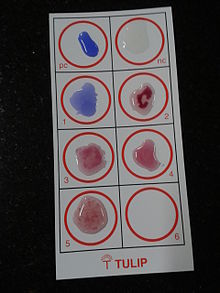Gruber-Widal reaction
The Gruber-Widal reaction , named after the hygienist Max von Gruber (1853–1927) and the French pathologist Fernand Widal (1862–1929), is used to detect specific antibodies with the help of antigens on known bacteria. By determining the titer , the Gruber-Widal reaction allows a conclusion to be drawn about the concentration of these antibodies in a patient's blood serum .
execution
Blood serum is diluted in increasing concentration in physiological saline solution, combined with a suspension of killed bacteria and incubated for 24 hours at 37 ° C., the agglutinate of antibody and antigen- bearing bacteria precipitating in the form of a white cloudiness. The greatest dilution with a precipitate indicates the titer. The titer can be read off with an agglutinoscope . In addition to the level, the course of the titer is important for assessing whether an acute infection is present: an increase in titer within seven days is a prerequisite for an acute infection. The Gruber-Widal reaction is used to diagnose, for example, salmonellosis , Escherichia coli infections and dysentery . In a modified form, it is also used in the detection of brucellosis as the Widal-Wright reaction .
literature
- Death of Fernand Widal. In: American Journal of Public Health and the nation's health. Volume 19, Number 4, April 1929, pp. 415-416, ISSN 0002-9572 . PMID 18012726 . PMC 1581097 (free full text).
- H. Mochmann, W. Köhler: [The discovery of bacterial agglutinins and the origin of serodiagnosis - a priority battle from the history of medical microbiology. 2: Biographical sketches of the contenders Max v. Gruber (1853-1927), Richard Pfeiffer (1858-1945), Herbert Edward Durham (1869-1921) and Fernand Widal (1862-1929)] Z. Ärztl. Fortbildung (Jena) (1989) 83 (21): pp. 1085-1090, PMID 2698554
